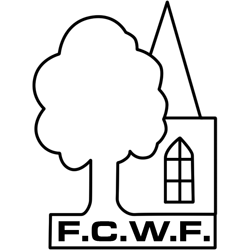Bird Blog
Welcome to the Bird Blog where you can catch up with all the latest reports on what the birds are doing on the site.
May 2021
Are you enjoying the birdlife of Childwall Woods and Fields? There is so much happening all the time and I personally don’t have enough of that “time” to get the maximum benefit from the facilities of our wonderful site.
For the last two years, I have been recording and reporting all the birds I have seen in my twice-weekly walks. Now that I have been joined by other birders with their various camera and identification skills, the observations have expanded enormously. Several bird species have been seen in the last few weeks, carrying nesting materials around and a number of nests have been located.
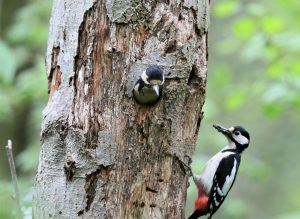
Woodpeckers – Danny Carmichael – May 2021
In particular, nuthatch and great spotted woodpeckers are not particularly shy about adopting holes in trees in full view.
There are some fabulous pictures just waiting to be incorporated into the ‘gallery page’ soon to be on the website.
The total list of birds for the site now stands at 55, with all but three of them being seen this year. Apart from the redpolls in February and March, we have added grey heron, common gull, and lapwing flying over. In March a ring-necked parakeet was seen in the woods by three separate observers. This is a long-overdue visit, as this particular bird is well established in Sefton Park and has been seen widely in south Liverpool in recent months. It was only a question of time before one paid us a visit to CWF.
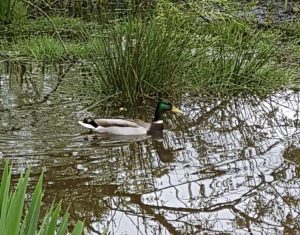
A Mallard – B Cameron – May 2021
There have also been two really surprising visitors in the last month – a coot and a male mallard duck! Perhaps they had heard about our plans to create a pond on the top field and were just sussing out the land!
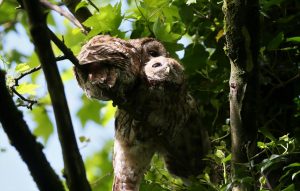
A pair of Tawny Owls – Danny Carmichael – May 2021
For two years I tried in vain to hear tawny owls calling in the woods. Others heard them but I didn’t! This year, however, the team has encountered a pair of these fabulous birds and I am so pleased to have seen them for my personal list.
So, spring continues. Keep your eyes open and please let us know if you manage to catch sight of anything interesting. And don’t forget our Facebook page for all our news of what’s happening on Childwall Woods and Fields.
Author
David G Holland MSc CEnv MCIEEM
Consultant Ecologist
President Friends of Childwall Woods and Fields
March 2021
Do you know we have two different members of the pigeon family in the woods, the woodpigeon, and the stock dove? The one we are all familiar with is the woodpigeon, which has a five-note call. He goes ‘coo-cooo-coo—-coo-coo.’ Some years ago on holiday in East Anglia I heard the local woodies going through a sequence of several rounds of five notes and at the end, they paused and added a single short ‘coo’. How strange, I thought; it must be a regional dialect, so to speak. When I returned home I discovered that the local woodpigeons all do this as well. Listen out for it.
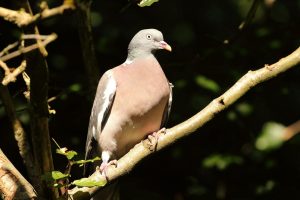
A Woodpigeon – Danny Carmichael
If you think you may have seen a feral pigeon in the woods it will most certainly be a stock dove. It is much smaller than the woodpigeon and its call is distinctively different. It makes a sort of ‘woowh-woowh — whoowh-woowh’ sound. In appearance, it has two very small dark wing bars, whereas ferals have a variety of bigger and different wing bars. Other distinctions can be seen in the eye colouring of the three birds. Stock doves – black eyes. Woodpigeon – white eye with black centre. Ferals – sort of orange colour.
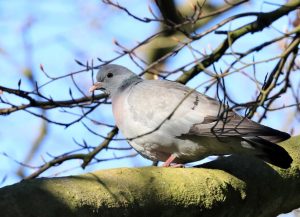
Stock dove. – Andy Scott
Finally, to round off our local pigeons we must include the gentle collared dove, which is light grey in colour, apart from a dark half collar on its neck. They have a distinctive three-note call, ‘coo-coooo-coo’. Collared doves are normally seen in association with buildings and have not been seen so far on our site. There you are – sorted.
If you want to check out the different songs and calls that birds make, you can find them on the web or click on the links above. If you know what bird you are looking for, type in its name and add ‘call or song’. A selection of websites will give you help. The BTO has many guides to distinguish between similar birds in groups like the warblers.
Now to the bird story of this year so far – the redpolls. Two different species have now been identified by the experts. Most of the birds are lesser redpolls, but the more uncommon mealy redpolls have also been seen in ones or twos in the mixed flocks of lesser redpolls, siskins, and goldfinches. They spend much of their time feeding amongst the alders and birch trees. At this point of writing the redpolls and the siskins are still present on the site but they are not expected to stay for much longer.
Three more birds have been added to the site list since my last blog. A flock of lapwings were seen mid-February by Chris Tynan RSPB and others looking at the redpolls. A mistle thrush has been heard, seen, and photographed this week. And lastly, a long-expected ring-necked parakeet was spotted by several birders on the 6th of March. Parakeets have been resident in Sefton Park for many years so it was only a matter of time before they appeared here. These take the site list to 50. The total for 2021 so far is 34.
Finally, we have installed bird feeders in the woods, which are proving popular with birds, squirrels, and people! The main feeding station is in the triangle of grass between the carriageway drive and the tv studios. Walk around the corner and you will see a flurry of birds flitting back and forth from trees to feeders. So far, four different members of the tit family have been seen, as well as nuthatch, robin, blackbird, dunnock, magpie, woodpecker, and woodpigeon. The birds are so tolerant of human presence, you can stand within 10 metres and get very good close-up views of them.
Squirrels? Well yes, they love the feeders too! Initially, they discovered how to break into some of the feeders and make off with the fat balls, so we are in the business of working out how to secure all the feeders. Humans? It is very pleasing to see how many people are appreciating being able to watch all this continuous activity at such close quarters. A second feeding station is being developed at the other end of the woods near the junction with the path from the top field to the path from Quickswood Close.
>>>>>>>>>>>>>>>>>>>>>>>>>>>>>>>>>>>>>>>>>>
February 2021
I trust you are making the most of our wonderful Childwall Woods and Fields site as we struggle to cope with the effects of Covid19 lockdown etc. Chris Packham and the Winter Watch team made a major point about the benefits to our mental and physical wellbeing by getting out and enjoying nature.
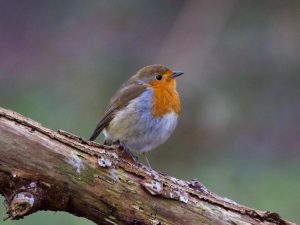
Andy Scott
Are you getting excited by the signs of approaching spring? Song thrushes are marking out their territories with their loud repetitive songs, great tits are calling, greenfinches are making their varied calls, robins are singing for all they are worth and many different birds are chasing around in pairs. And the weather will start to warm up!
I have now completed two years of recording birds on the site (215 site visits) This gives me a reason to review the data for the period and to update the webpage with all the new bird species that have been added to the site list. Check it out. Questions about the breeding habits of our birds posed in 2019 have been answered, such as arrival times of the seasonal visitors and duration of territorial calling or singing, but more have been posed.
Moving from 2019 to 2020 has thrown up some interesting changes. Gulls fly over the site all the time but none of them ever touched down on the ground. The school playing field is an obvious place to see them but in 2019 none were ever recorded. However, herring gulls and lesser black-backed gulls have both been recorded on the grass several times through 2020 and thus are easily added to the site list. I have to confess I have great difficulty identifying them in the air but have still managed to name a few as they have gone overhead. Feral pigeons scarcely appeared in 2019 but that changed last year, being seen on the tv studios and on houses on Childwall Lane. It may be my observational skills improved last year but I did notice chaffinches and linnets quite often during the summer as a change from the previous year.
A small team of birding enthusiasts has been developing over the last year, which means more eyes watching and better identification skills are available. It is these extra observers who have added pheasant, spotted flycatcher and wheatear to the list. When redpolls were spotted on the top field in February this year together with siskins, it brought a rush of local birders to see these pretty little finches. Suddenly the available expertise expanded enormously and some amazing pictures were taken!
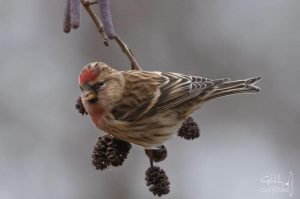
Redpoll – Feb 2021 – Gill Griffiths
The current list stands at 47 species but I hope to top the 50 mark by the end of the year. Black headed gull and grey heron should be on the list by now. One bird in particular is on my want list and that is the ring-necked parakeet, which has been established in Sefton Park for many years and has recently been reported in several other different localities in South Liverpool.
That’s it for now. Catching news from my birder team I hope to be able to write my blog more frequently and keep you up to date with bird events as they happen.
Author: David G Holland MSc CEnv MCIEEM
Consultant Ecologist
President Friends of Childwall Woods and Fields
—————————————————————————–
June 2020
So much has happened since my last blog in February – a whole new generation of birds, a change of policy for recording birds, meetings with three other bird watchers and seven new species added to the 2019 list.
Many of you have seen the first fledglings of the year. Some of you have been watching the comings and goings of nuthatches and woodpeckers in holes in the trees. A veteran tree (look that up on the veteran tree page) near the end of the carriageway, was home to both species and provided a lot of interest to onlookers.
Last year, I wrote of the importance of listening to bird calls and songs for identifying them when you can’t actually see them. Analysis of this year’s data shows that back in January 25% of the records were made by sound only. As the seasons progressed and the birds were too often hidden in the leaves, the figure has risen to 33%. One bird in particular, is very difficult to see in the woods and that is the stock dove. It looks like a feral pigeon, but of course, ferals never visit the woods. The stock dove starts calling with its double coo in March and can still be heard in June (Woodpigeons have a five-note call). So keep your ears open folks.
At the start of the survey in January 2019, the guidelines were drawn up to include all birds to be seen or heard on the site or in the fringe areas just beyond the boundary. Birds, such as gulls, were not counted as they were not deemed to be using the air space for the site. This, however, did cause problems over which sightings to include. In April 2020, after consultation with a number of local birders about how they deal with their sites, the guidelines have been changed. EVERYTHING NOW SEEN, COUNTS, which is just as well as there have been some unexpected over-flyers in 2020.
The seven new birds for 2020 are herring gull and lesser black-backed gulls (both have actually touched down on the school playing fields this year), siskin, sparrowhawk (I had waited 15 months to see this one!) swift (seen on two occasions in June) and, unexpectedly flying over, cormorant (twice) and Canada goose (three times)
I have bumped into three other bird watchers this year (at 2 metres of course!) and swapped notes. They have reported three surprising visitors seen just passing through. Spotted flycatcher and wheatear were on their migration journeys, but what can we make of the pheasant spotted in the woodland plantation on the middle level? The last bird for the site list is the tawny owl – my frustration bird! I visited the woods over 30 times from October 2019 to March 2020 and sat in my car in the dark at all sorts of hours, trying to hear one calling. I failed completely, but a security camera on Childwall Abbey Road has been recording it consistently right through the winter months. It is very reassuring for me to hear this as positive evidence for the inclusion of tawny owl for the site. So there you have it, forty, plus four species recorded in 18 months on Childwall Woods and Fields LNR. I am sure there will be more to follow.
Author: David G Holland MSc CEnv MCIEEM
Consultant Ecologist
President Friends of Childwall Woods and Fields
……………………………………………………………………………………………………………….
February 2020
What is the story so far?
In December 2018 the British Trust for Ornithology (BTO) challenged birders who submit their records to the BirdTrack database, to do 100 visits at one site in 2019. Well this was achieved on our site (plus 5 extra!) and lots of fascinating observations have emerged.
All through the breeding season last year, great tits were calling and song thrushes were singing, only to go silent in mid-summer (breeding job done!). Both of them have now started up again – great tit in December and song thrush setting up territory in January. Listen out for them. On the other hand, greenfinches finished their calling in July and have now started up again in January whereas blue tits never stopped calling out through the year.
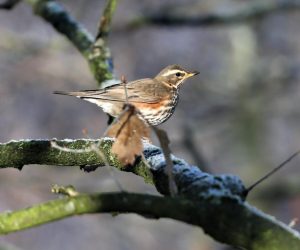
Danny Carmichael Dec ’22
Have you seen any redwings yet? These members of the thrush family are the only migratory birds that visit the site in winter. They have speckled chests like the other thrushes and an attractive yellow eye-stripe. They are usually seen in the tops of trees and if you spot 3 or more blackbird-sized birds flying around, they are almost certainly to be redwings and can number 20 or more at a time (blackbirds don’t move around in flocks on the site). Whilst you are in the beech woods, look out for the noisy jays – colourful birds with their pink backs and breasts and a conspicuous white patch on the rumps, which are noticeable in flight. They make raucous calls to attract your attention. And now for the “biggy”, literally – the largest birds on the site. A couple of buzzards made frequent use of the site during the breeding season last year, but again like the great tits and the song thrushes, they disappeared later in the summer. The good news is that these big birds of prey are back again, having been seen several times in the last month or so. Look out for them sitting in a tree or soaring around being mobbed by crows or magpies.
Finally for this blog. Have you heard any tawny owls calling in the woods at night? In spite of several reports of these birds being heard here, I have gone to Countisbury Drive 28 times since mid-October at times varying between 6.00pm and 4.00am in the night, and not heard one TOOT! Whilst I have been unable to record them, do you know any different? If so, please drop me an email with the details to bcfcwf@gmail.com
If you see things you would like to share at any time, just email them in for inclusion. It would be great to hear of your own sightings.
Author: David G Holland MSc CEnv MCIEEM
Consultant Ecologist
President Friends of Childwall Woods and Fields

